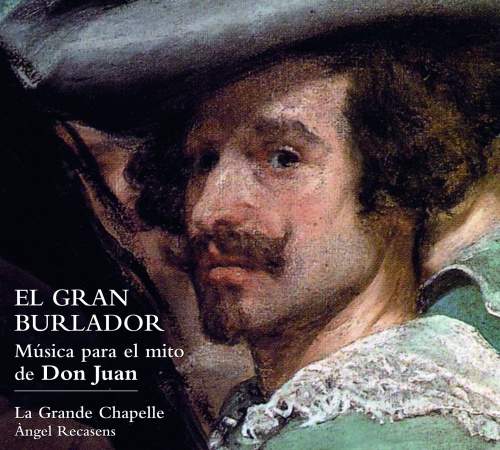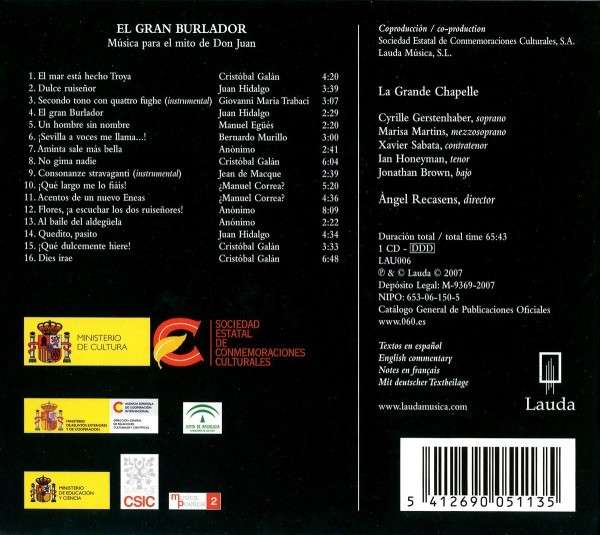
classical music distribution


(Produkt nie został jeszcze oceniony)
kompozytor
Galan, Cristobal;
Hidalgo, Juan;
Trabaci, Giovanni Maria
tytuł
The Great Seducer. Music for the myth of Don Juan
wykonawcy
La Grande Chapelle;
Recasens, Angel
Recasens, Angel
nr katalogowy
LAU 006
opis
Don Juan is portrayed in relation to the cardinal points of his dramatic action: his four conquests –the noblewomen Isabela and doña Ana, and the commoners Tisbea and Aminta–, love's meaning –for him and for them–, his arrogance as a playboy, his birth as a new Aeneas... All this, with the aim of being able to follow the course of the legend, giving a voice and music to each protagonist. • Tirso's verses have been illustrated by turning to the music of the most inspired composers of Spain's Baroque period, such as Cristóbal Galán, Juan Hidalgo, Bernardo Murillo, Manuel Correa, Manuel de Egüés, and the inevitable anonymous composers. In many instances the majority of the compositions, in addition to being unpublished, are worldwide premiere recordings. • The use of a variety of registers from the 17th century Spanish repertory is prominent: from pieces of extraordinary and penetrating lyricism, masterfully executed by the sopranos Cyrille Gerstenhaber and Marisa Martins, to tonos humanos (secular songs), instrumental interludes by Trabaci and Macque, chapel masters from Naples –where the action begins–, folk rhythms and dances, and the magnificent 12-voice Dies irae sequence by Galán that concludes the register. Àngel Recasens, in his last recording –a posthumous one–, gives us some emotive and elegant performances that aim for dramatic purpose and proportionality, converting a practically unknown repertory into works destined to endure.
nośnik
CD
gatunek
Muzyka klasyczna
producent
Lauda
data wydania
22-08-2012
EAN / kod kreskowy
5412690051135

(Produkt nie został jeszcze oceniony)
cena 79,00 zł
lubProdukt na zamówienie
Wysyłka ustalana indywidualnie.
Darmowa wysyłka dla zamówień powyżej 300 zł!
Darmowy kurier dla zamówień powyżej 500 zł!
sprawdź koszty wysyłkiProduktu jeszcze nie zrecenzowano, chcesz być pierwszy?
Klienci, którzy kupili ten produkt, kupili również
różni kompozytorzy
Four Virtuosi Play Chinese Traditional Music - Plum Blossom Melody
8.225844
Pozostałe płyty tego kompozytora
różni kompozytorzy
The Kingdoms of Castille: Mazzocchi, Falconieri, Hidalgo, Marin, Zipoli
DSL 92131
Gesualdo, Carlo, Valente, Antonio, Trabaci, Giovanni Maria
Valente/Gesualdo/Trabaci: Seconde Stravaganze
SY 99170
różni kompozytorzy
Lecons De Tenebres - Samedi Saint dans l'Italie du Seicento - Viadana, Trabaci, Merula, Sances, Cima, ...
AVR 120315
Pozostałe płyty tego wykonawcy
Napisz recenzję dla: The Great Seducer. Music for the myth of Don Juan
Zapytaj o dostępność produktu
Twoje zapytanie:
Odpowiemy na adres:
Produkt został dodany do koszyka

Galan, Cristobal, Hidalgo, Juan, Trabaci, Giovanni Maria
The Great Seducer. Music for the myth of Don Juan
1 szt











































